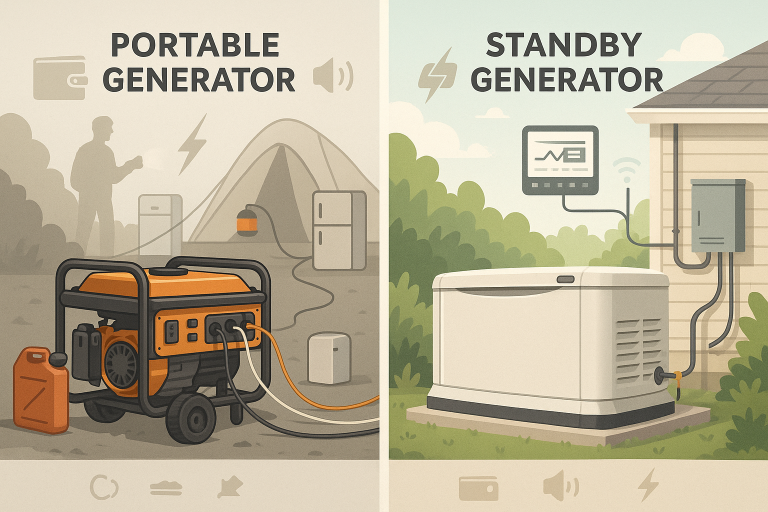How to Maintain Your Generator for Long-Term Use
Generators are lifelines during power outages, natural disasters, or off-grid living. However, like any mechanical equipment, they require consistent care to perform reliably over the years. Neglecting maintenance can lead to costly repairs, reduced efficiency, or even complete failure when you need it most. This detailed guide walks you through essential steps to keep your generator running smoothly for decades.
1. The Lifeline: Regular Oil Changes
Why it matters: Oil lubricates the engine’s internal components, reducing friction and preventing wear. Over time, oil breaks down, accumulates debris, and loses viscosity, leading to engine damage.
Steps to follow:
- Break-in period: After the first 20–30 hours of use, replace the oil to remove metal shavings from initial wear.
- Routine changes: Change oil every 50–100 hours (check your manual). For standby generators, aim for annual changes.
- Oil type: Use manufacturer-recommended oil (e.g., 10W-30 for temperature flexibility). Synthetic oils offer better performance in extreme conditions.
- Filter replacement: Always replace the oil filter with each change to prevent contaminants from recirculating.
Pro tip: Keep spare oil and filters on hand for emergencies.
2. Fuel System: Prevent Clogs and Degradation
Why it matters: Stale fuel clogs carburetors and injectors, while ethanol-blended gas attracts moisture, causing corrosion.
Steps to follow:
- Stabilize fuel: Add a fuel stabilizer (e.g., STA-BIL) if storing the generator for >30 days. Run the engine for 10 minutes to circulate treated fuel.
- Storage prep:
- Portable generators: Drain the tank and carburetor completely.
- Standby units: Keep the tank full to minimize condensation.
- Annual inspection: Clean fuel lines, replace filters, and inspect for leaks. For carbureted models, disassemble and clean the carburetor annually.
Pro tip: Use ethanol-free gasoline or additives to counteract ethanol’s corrosive effects.
3. Air Filter: Breathe Easy
Why it matters: A dirty air filter restricts airflow, forcing the engine to work harder and reducing efficiency.
Steps to follow:
- Inspect every 100 hours:
- Foam filters: Wash with soapy water, dry thoroughly, and lightly oil.
- Paper filters: Replace if discolored or clogged.
- Dusty environments: Clean/replace filters more frequently (e.g., every 25–50 hours on construction sites).
Pro tip: Cover the air intake during storage to prevent pests from nesting inside.
4. Spark Plug: Ignite Reliability
Why it matters: A fouled or worn spark plug causes hard starts, misfires, and poor fuel economy.
Steps to follow:
- Check every 200 hours: Remove the plug and inspect for carbon buildup or corrosion. Clean deposits with a wire brush.
- Replace every 2–3 years: Use the manufacturer-recommended plug type (e.g., NGK, Champion).
- Set the gap: Adjust the electrode gap using a feeler gauge (refer to the manual for specs).
Pro tip: Apply anti-seize compound to the plug threads to ease future removal.
5. Battery Care (Standby Generators)
Why it matters: Dead batteries are the #1 cause of standby generator failure.
Steps to follow:
- Trickle charging: Use a maintenance charger to keep the battery at full charge.
- Terminal maintenance: Clean corrosion with a mix of baking soda and water. Apply dielectric grease to prevent future buildup.
- Electrolyte levels (for lead-acid batteries): Top off with distilled water if plates are exposed.
Pro tip: Replace batteries every 3–5 years, even if they appear functional.
6. Cooling System: Prevent Overheating
Why it matters: Overheating warps engine components and shortens lifespan.
Steps to follow:
- Liquid-cooled generators:
- Check coolant levels annually.
- Flush and replace coolant every 2–3 years.
- Air-cooled generators:
- Clean cooling fins and vents with compressed air.
- Ensure 3–5 feet of clearance around the unit for airflow.
Pro tip: Install a temperature alarm for early overheating warnings.
7. Belts and Hoses: Avoid Catastrophic Failures
Why it matters: Cracked belts or brittle hoses can snap during operation, disabling the generator.
Steps to follow:
- Inspect belts: Check for cracks, fraying, or improper tension. Adjust alignment if skewed.
- Hoses: Squeeze hoses to detect brittleness. Replace if leaking or cracked.
Pro tip: Keep spare belts and hoses in your maintenance kit.
8. Load Testing: Keep It Ready for Action
Why it matters: Running the generator under load ensures components stay lubricated and functional.
Steps to follow:
- Standby units: Let the generator run weekly (auto-mode) or monthly (manual) at 50–80% load for 30 minutes.
- Portable units: Plug in appliances periodically to simulate real-world use.
Pro tip: Use a clamp meter to verify output voltage and amperage.
9. Routine Inspections: Catch Problems Early
Why it matters: Small issues (loose bolts, oil leaks) can escalate if ignored.
Steps to follow:
- Monthly visual checks: Tighten loose bolts, inspect for corrosion, and clean debris.
- Annual deep clean: Wipe the exterior with a damp cloth and degreaser.
Pro tip: Use a checklist to ensure no step is missed.
10. Storage: Prepare for Dormancy
Why it matters: Improper storage leads to varnished fuel, corroded parts, or pest infestations.
Steps to follow:
- Short-term (<1 month): Stabilize fuel and run monthly.
- Long-term (>1 month):
- Drain fuel from portables.
- Store in a dry, ventilated area away from direct sunlight.
- Cover with a breathable tarp to deter dust and rodents.
Pro tip: Place mothballs or rodent repellent around the unit during storage.
11. Professional Servicing: When to Call Experts
Why it matters: Technicians spot hidden issues (e.g., internal corrosion, voltage irregularities).
Steps to follow:
- Annual checkup: Schedule a professional inspection of internal components, wiring, and software (for inverter/smart generators).
- Load bank testing: For commercial units, professionals simulate 100% load to validate performance.
Pro tip: Keep a service contract for standby generators to ensure priority response.
Bonus Tips for Longevity
- Safety first: Always disconnect the spark plug or battery before servicing.
- Log maintenance: Track dates, hours, and actions in a notebook or app.
- Use genuine parts: Aftermarket components may void warranties or cause compatibility issues.
- Read the manual: Follow model-specific guidelines for oil types, intervals, and troubleshooting.
Conclusion: Invest in Reliability
A well-maintained generator can last 20–30 years, saving you thousands in replacement costs. By adhering to this regimen—prioritizing oil, fuel, and load testing—you ensure your generator is always ready to power through storms, outages, or adventures. Remember: Maintenance isn’t an expense; it’s an investment in peace of mind. Start your schedule today, and your generator will repay you with unwavering reliability. ⚡🔧



